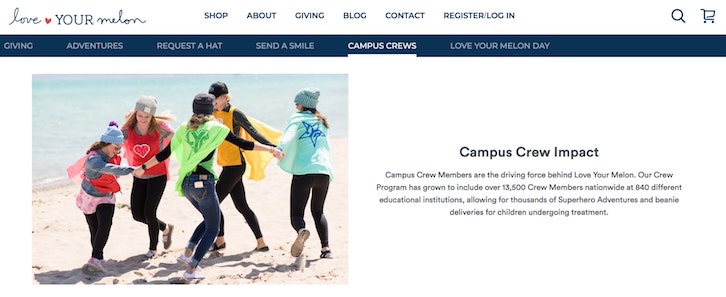Social Entrepreneurship: How to Become a Changemaker Through Business

Some people start businesses to improve the quality of their life. Others seek to work for themselves. And some see an opportunity in the market they can't resist.
But sometimes the desire to use business as a means of creating positive change ignites the entrepreneurial spirit in you.
This is called “social entrepreneurship,” and it’s an approach to business that’s gaining popularity as globalization brings conversations about sustainability and international development to a world stage. It’s also leading more people to ask themselves, “What can I do for the world today?”
Social entrepreneurship involves starting mission-based enterprises that dedicate some or even all of their profits toward furthering a cause—giving their customers a purpose behind every purchase.
- What is social entrepreneurship?
- Finding a product to sell and a mission to lead
- Funding your social enterprise
- Marketing your mission
- The rise of social entrepreneurship
What is social entrepreneurship?
Social entrepreneurship is when you start a business for a philanthropic cause. Also called “altruistic entrepreneurship”, it’s broad and can include both non-profit organizations like Doctors Without Borders, which rely almost exclusively on donations and grants, and for-profit companies like Tesla, which turns a profit by putting its clean energy products front and center.
Social entrepreneurship can also include bricks-and-mortar establishments and online business ideas. TOMS, for example, opts for both.
Social entrepreneurs are innovators who start companies and organizations that are committed to giving back.
What’s a social enterprise?
A social enterprise is a type of business where the bottom line and success metrics are measured in more than just profits. Instead, social enterprises typically measure success based on a triple bottom line:
- People. The human impact of your business, and your ability to affect social change, improve lives, and develops a community in a sustainable way.
- Planet. Your environmental impact—how you contribute to a sustainable planet or reduce the carbon footprint (CO2 emissions) of your business and customers.
- Profit. Like traditional businesses, social enterprises need to make money in order to sustain themselves, pay workers, and grow as an enterprise.
Social entrepreneurship is about harnessing commerce for a good cause.
What are the types of social entrepreneurship?
Social entrepreneurship takes many other forms too:
- Nonprofit. A tax-exempt, non-business entity that invests excess funds back into the mission.
- Co-operative. A business organized by and for its members. Credit unions and community grocery stores are some examples of co-ops. REI is also an example of a co-op.
- Social purpose business. These businesses start on the foundation of addressing a social mission.
- Social firm. Social firms employ those in the community who need jobs. FareStart is a great example—it employs at-risk youth and serves healthful meals.
- Socially responsible business. These companies support social missions as a part of their day-to-day business operations.
- For-profit. Perhaps the vaguest category, these businesses are profit-first but donate funds, raise awareness, or otherwise support causes. Warby Parker’s Buy a Pair, Give a Pair program is a prime example.

Do social entrepreneurs make money?
The short answer is that it depends. In many cases, social entrepreneurs do make money. They’re living proof that you can be successful as a business owner and do good at the same time. However, in some cases, the entrepreneurs elect not to take a profit for themselves.
One of the challenges to succeeding in social entrepreneurship is that it’s easy to measure profit (did you make money or did you not make money?), but it’s not as easy to measure your impact on people or the planet and communicate that to others.
Social entrepreneurs adopt a business model that puts their mission at the center of their business and are held accountable to their customers and stakeholders based on their proposed impact.
The benefits of building a social enterprise
For today’s consumers and businesses, social responsibility is a growing priority as concerns about climate change, international development, and supply chain ethics become a more prominent topic of international discussion.
In a CSR survey by Cone Communications, 87% said they will purchase a product because a company supports an issue they care about. This reflects a shift in consumer awareness about the impact of their purchase decisions. Not only are businesses held to a higher standard, but many consumers are holding themselves to a higher standard as well.
So while social enterprises, by definition, must dedicate a portion of their profits to the impact they want to make, they do enjoy the following benefits that help them succeed:
- Mission-based branding. A company story with a cause at its core makes consumers feel good about every purchase they make from you.
- Partnership opportunities. A social enterprise, because of its mission-based motivations, can partner with other non-profit organizations and for-profit companies to leverage existing audiences and established reputations to create a presence in their market. “In kind” resources and discounts are not uncommon for social enterprises.
- Press coverage. Publications and blogs love to cover social innovation and changemakers and their impact, helping social enterprises evangelize their efforts and share their impact.
- Certifications and support systems. Social enterprises can be eligible for grants, “impact investing” opportunities that focus on job creation and sustainability, and special certifications such as a Benefit Corporation status that make it easier to establish credibility, commit to transparency, and attract customers, employees, volunteers, and investors.
For the sake of this piece, we’ll look at what it takes to create a sustainable for-profit social enterprise. And that starts, as most businesses do, with figuring out which of your business ideas you want to pursue and what that business will sell.
Finding a product to sell and a mission to lead
The mission might come first for social entrepreneurs, but that doesn’t eclipse the importance of choosing the right things to make and sell. When all is said and done, a for-profit social enterprise needs to make money to survive just like any other business idea.
But there’s a pattern amongst successful social enterprises of establishing a good “product-cause fit” that aligns their mission with what they sell.
Social entrepreneurship examples
Taaluma Totes, which produces socially responsible bags made with fabrics sourced from across the globe, was founded to cultivate more connection between cultures around the world. Plus, it uses 20% of its profits as micro loans for farmers and small business owners in the countries from which its fabrics are sourced—enabling the farmers and small business owners to continue to fund and run their fabric operations.

Chocolate company Askinosie also focuses on sourcing from international markets. Its cocoa beans come from the Amazon, the Philippines, Tanzania, and Ecuador. Its transparency report publicly shows exactly how much is paid out to small farmers. Fellow chocolate brand Taza Chocolate also publishes its own transparency report to show how it supports farmers.
Cotopaxi makes and sells outdoor gear for adventurers and travelers, dedicating 2% of total revenue to provide grants to specific non-profits that seek to alleviate poverty in different parts of the world.
Social entrepreneur David Merritt founded two ventures with a more local focus that address social problems facing Detroit youths:
- Merit: a for-profit apparel brand that donates 20% of all purchases to fund college scholarships for underserved youth.

- Give Merit: a non-profit organization that raises money for and hosts youth programs.

Learn More: Find out how to start a t-shirt business of your own.
LSTN Sound Co. sells premium headphones and donates a portion of its profits to the Starkey Hearing Foundation to help restore hearing. It’s helped more than 30,000 people around the world.
Love Your Melon sells beanies and hats and, on top of donating 50% of profits to pediatric cancer research and supporting patients, has a Campus Crew Program that mobilizes students across the United States to help with its mission.

These are only a handful of the many examples of ecommerce-based social enterprises that do a great job of not only tying a sense of purpose to their products, but using traditional business strategies, such as event marketing and giveaways, to promote their mission.
Defining your mission and illustrating your impact
A social enterprise’s mission is a competitive advantage that can help them stand out in a crowded market—if they can communicate their motivation and the impact they can make.
Many social enterprises adopt a model where they donate a portion of profits to a cause, but that's not the only way to position your company as a social enterprise.
"It’s not just saying, ‘Hey, we have a social mission as an organization, and X percent of our sales goes to nonprofit X, Y, and Z.’ I think it needs to be deeper and more authentic than that."
There are also social enterprises that focus on:
- Creating jobs within the communities they care about, such as hiring local ex-convicts or ethically outsourcing production to communities in need of fair work and career development opportunities.
- Reducing their carbon footprint by planting trees or going out of their way to reduce carbon emissions throughout their entire supply chain and educating customers about the topic.
- Hosting workshops and people-development initiatives to teach skills and empower others to build better lives for themselves and their communities.
- Advocating for diversity and inclusion on behalf of underrepresented groups and becoming an engine of inspiration, such as GoldieBlox does by making toys to expose young girls to the joys of engineering.

Transparency and sustainable impact are essential for a successful social enterprise. And these things are easier to achieve if your cause is close to your heart and measurable.
“Integrity is doing the right thing, even when no one is watching,” in the words of C.S Lewis.
Transparency is about visibly demonstrating your integrity and holding yourself accountable to your mission and the people who support it.
Depending on your mission, you can directly implement your plans for change as a social entrepreneur and expand your contributions as you grow. But if you choose to partner with non-profit organizations (NPOs) to help execute the “social” part of your social enterprise (as many do), be sure to do your homework before you reach out. Ask questions like:
- What am I ultimately giving back to?
- How will my contributions actually be used and what are the organization’s operating costs?
- How does the organization measure its success?
- Is their impact sustainable or will it only end up doing more harm in the long run?
- Does this organization have an ethical history as a non-profit?
This is all part of your founding story—the tale of why you started your business—and will likely come up again and again in your elevator pitch, About page, PR efforts, and more. So refine your story with your mission in mind and your action plan for creating change.
Funding your social enterprise
Social enterprises are accountable to the cause they support, which means automatically setting aside a portion of future revenue to invest in increasing impact.
Social entrepreneurs have to be creative with how they raise money, and crowdfunding is a popular option.
Crowdfunding websites such as Kickstarter not only help you raise money to get your idea off the ground but also expose your mission to a community that exists on the very premise of supporting projects and causes they believe in.
GoldieBlox's Kickstarter campaign exceeded its funding goal by a landslide and helped launch the successful business it is today.
There are also a growing number of grants you can apply to for social enterprises that meet specific requirements, and the trend of “impact investing,” where the return on investment expected isn’t just financial but includes social and environmental impact as well.
Marketing your mission
What works when it comes to marketing can vary from business to business, but the need for transparency and the “for-benefit” position that social enterprises adopt make certain marketing strategies especially effective at generating awareness.
After all, you’re marketing your mission, not just your business.
Free Webinar:
Marketing 101
Struggling to grow sales? Learn how to go from first day to first sale in this free training course.
Content marketing
Digital media and the internet enable storytelling at a scale that wasn’t possible before.
From shooting videos to sharing photos on social media, social enterprises can leverage content to share real stories of the impact they’re making and provide proof that every customer’s purchase helped do some good in the world.
Visit the affected community and film a documentary-style video. Or create an infographic for a data-based illustration of your impact or why your vision of change is needed.
There are ample opportunities for a social enterprise to spread its mission and tell its stories with content.
Learn more with these resources:
- 7 Free Content Creation Tools to Help You Earn More Engagement Online
- 8 Brilliant Blogs Run by Ecommerce Stores (And What You Can Learn From Them)
- 4 Ecommerce Blog Post Templates To Build Traffic For Your Store
Events
Since NPOs often host events for fundraising and other initiatives, social enterprises can partner with or sponsor the causes that relate to their mission.
Whereas this would be deemed a marketing expense for traditional businesses, for a social enterprise it can double as an investment in their cause.
Learn more in How Cotopaxi Build Its Brand and Spreads Its Vision With In-Person Events.
PR
With a feel-good story and a carefully crafted pitch, a social enterprise can win media mentions from bloggers and publications that are constantly on the lookout for something interesting to cover.
Since there’s a purpose behind your company, there’s usually a lot more meat to the story by default than there might be for a traditional business.
Learn more about getting media coverage for your brand:
- 7 Free Outreach Tools That Will Level Up Your Business Development Game
- How to Create a Press Kit That Gets Publicity for Your Business
- How to Write a Press Release That Journalists Won't Ignore
Social media
Purchasing isn’t the only way for people to support your mission. They can donate their voices online too.
According to an analysis by CoSchedule on why people share things online, 84% used social sharing as a way to support causes or issues they care about.
As long as you integrate your mission into your marketing, you can expect your audience to help you spread the word.
Learn more in these articles:
- How to Create a Social Media Content Calendar in 4 Simple Steps
- How to Create a Social Media Marketing Strategy: A Beginner's Guide
- 17 Social Media Marketing Strategies to Grow Your Online Sales
The rise of social entrepreneurship
Social entrepreneurship isn’t the only way a business can be for-benefit and not just for-profit.
Many companies are owning their social responsibility based on a growing belief that those with the power to do so can and should try to make the world a better place.
Our connected world has brought about a new era of awareness, where we can find problems to solve and lives to improve across the street or across the world if we choose.
People from all over are making the decision to make change in whatever way they can, whether it’s by being more conscious of what they buy as consumers or building an engine for social and environmental good by becoming entrepreneurs.
With a single website, you can reach a world of consumers who want to help you make a difference. Shopify is a flexible platform to build your site, share your mission, and generate sales to fund that mission. It’s all about figuring out your cause and what to sell on Shopify to support that cause.
